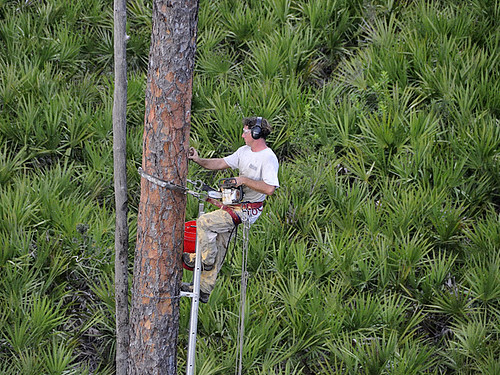 Belizean Yellow-headed Parrot (Amazona oratrix belizensis)A plan to transfer artificial cavity technology from the Red-cockaded woodpecker of the Southeastern U.S. to the Yellow-headed Parrot of Belize: The RCW-YHP Project
Belizean Yellow-headed Parrot (Amazona oratrix belizensis)A plan to transfer artificial cavity technology from the Red-cockaded woodpecker of the Southeastern U.S. to the Yellow-headed Parrot of Belize: The RCW-YHP Project
The Story
Michael Keys is a wildlife biologist. As a day job, he works for a public land management agency in Florida’s Big Bend region on the Gulf coast. One of the endangered species that he work with is the Red-cockaded woodpecker (RCW). Keys is also a traveling biologist who helps landowners throughout the range of the Red-cockaded Woodpecker recover populations of this amazing little bird. This venture gets him out into the field conducting on-the-ground conservation projects focused on this rare woodpecker species and southern pine forests in general. A cornerstone of his work with the RCW is installing artificial nest cavities in high up in live pine trees. A thousand miles south of here, another critically endangered bird also lives in cavities in pine trees. It will benefit from the same type of artificial cavities as the RCW.
The Parrot
The Yellow-headed Parrot (YHP) has bright beautiful plumage and incredible abilities to mimic human speech. Sadly, these traits are also the leading causes of the species’ endangered status. The Belizean Yellow-headed Parrot (Amazona oratrix belizensis) has been experiencing severe population declines since at least the mid 1970s when poachers began aggressively pursuing them for the illegal pet trade. The illegal harvest of parrot chicks and habitat loss of open pine savannas has left less than 7,000 YHPs in the wild today according to Bird Life International. Extinction in our lifetime is a real possibility for this species. The fascinating thing is that the YHP nests in cavities in Caribbean pine trees in habitats that are amazingly similar to our longleaf and slash pine forests of Florida where the Red-Cockaded Woodpecker makes its home.
The Impact
No one has ever tried this before, but we believe cavity installation techniques similar to what has worked for the Red-cockaded woodpecker can be employed to provide safe nesting habitat for the much rarer Yellow-headed Parrot. In fact, poaching is the number one problem for all species of Amazon parrots, and creation of artificial cavities high in the native Caribbean pines requires specialized climbing gear that the average poacher will not have.
Our plan is to make nest cavities above the reach of bird grabbers and give these birds a fighting chance to reproduce in the wild.
The Partnership
 Darrell Novello, left, was a champion of Yellow-headed Parrot conservation in Belize before his untimely death. Steve Morrison, right, is working on pine savanna conservation in Belize and assisting Michael Keys on this project. Image by Steve Morrison. Our goal is to contribute to the survival of Yellow-Headed Parrot through direct conservation action, research and community participation with partnerships in Belize. This project – the RCW-YHP Project - will be managed by a partnership of staff who work at TIDE, Belize (Toledo Institute for Development and Environment), Steve Morrison (an employee of a national conservation NGO who is based in Central Florida) and myself, Michael Keys.
Darrell Novello, left, was a champion of Yellow-headed Parrot conservation in Belize before his untimely death. Steve Morrison, right, is working on pine savanna conservation in Belize and assisting Michael Keys on this project. Image by Steve Morrison. Our goal is to contribute to the survival of Yellow-Headed Parrot through direct conservation action, research and community participation with partnerships in Belize. This project – the RCW-YHP Project - will be managed by a partnership of staff who work at TIDE, Belize (Toledo Institute for Development and Environment), Steve Morrison (an employee of a national conservation NGO who is based in Central Florida) and myself, Michael Keys.
The Need
Michael Keys funding plan is simple, but he can't completely self-finance his way back and forth to remote Belize savannas with boxes of equipment and supplies. His resources, tools of the trade and committed conservation partners to initiate a pilot project and test the theory that artificial cavity creation will greatly benefit the YHP. He simply need funds to cover the costs associated with travel, creation of nest boxes and shipping of materials to/from Belize to start construction. His goal is to raise enough money to cover the costs of an initial expedition in January 2012 and a follow-up trip within the year to assess results, refine techniques and continue with installations of nest boxes.
All funds will go directly to support creation of artificial nest cavities in Payne’s Creek National Park, Toledo District, Belize. This project relies on donations to cover the costs of travel and shipping supplies, construction of the nest boxes and equipment such as chain saws and ladders used to install cavities.
Your Contribution
Gifts of any size are appreciated. We are seeking donations to help defray $2,500 in costs to install cavities in Belize during January, 2012. While this is a not-for-profit venture, donations are not currently tax-deductible.
If our financial goal is exceeded, surplus funds will be devoted to increasing monitoring of the success of the the project and expansion to other sites in Belize where the YHP still is found.
Sponsorship Levels (substitutions allowed for sponsors wishing an appreciation gift commensurate with lesser value donations)
Donate securely through PayPal either with your credit card or PayPal account.
